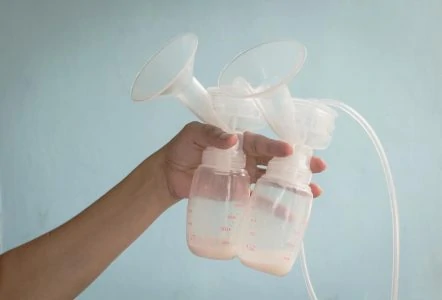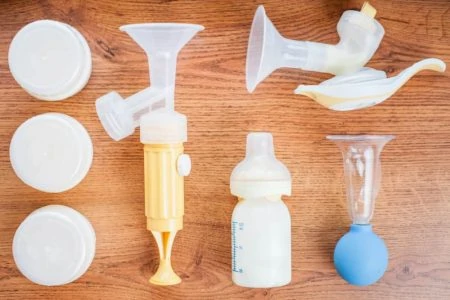Did you stop breastfeeding but now want to return to it? Relactation has to be the best news for any mom who wants to get back in the game.
Or perhaps you’re adopting and looking for answers about breastfeeding your adopted baby. The good news extends to women who have never had babies of their own. With a little bit of help from the doctor, they may be able to breastfeed.
Our medical team will discuss the nitty-gritty details of relactation and induced lactation. We’ll talk about whether it’s possible and what you can do to encourage your breasts to produce milk.
Key Takeaways
- Relactation is the process of rebuilding a woman’s breast milk supply after a period without breastfeeding, while induced lactation helps adoptive mothers produce milk.
- Skin-to-skin contact, pumping frequently, and consuming galactagogues can help increase milk production for relactation or induced lactation.
- Breast milk from induced lactation contains the same components and antibodies as regular breast milk, but it doesn’t have colostrum.
- Relactation success varies from person to person and depends on factors like baby’s age, nursing needs, and frequency of pumping.
What is Relactation?
In the simplest of definitions, relactation is building a woman’s breast milk supply that has reduced or dried up after a period without breastfeeding (1). The typical period may range from a couple of weeks to several months.
Relactation revolves around two key principles — bringing back the milk supply and getting your baby to latch and breastfeed again.
What About Induced Lactation?
Induced lactation, also known as adoptive breastfeeding, works similarly to relactation. It involves building up a milk supply in a woman who hasn’t been pregnant recently. This woman may have had children in the past, or she could be suffering from fertility difficulties.
Adoptive parents can consider this form of lactation to nourish their adopted babies naturally. If you know far enough in advance, the adoptive mom can go through hormone therapy to stimulate the production of hormones, estrogen, and progesterone.
In essence, you’ll be tricking your body into believing you are pregnant in hopes that your body will respond accordingly (2).
To encourage lactation, the mother will need to begin pumping milk at least two months before actually breastfeeding. Always remember that frequent pumping can enhance milk production. Working closely with a lactation consultant and your health care provider will give you the best chance of success.
What Is the Milk Composition From Induced Lactation?
Breast milk, whether after birth or from induced lactation or relactation, remains breast milk. It has the same components and antibodies needed by your baby.
However, milk from induced lactation does not contain colostrum. This nutrient-rich, yellowish fluid is the first to come from the breast, two to five days following the birth.
Colostrum is highly beneficial to a newborn baby and serves many functions in their bodies. It provides a nutritious and easily digestible meal for the baby and helps build their immunity.
Does the Baby’s Age Matter?
Ideally, the younger a baby is, the easier it will be for you to reintroduce the breast. Most babies under 1 month old will probably root and latch the moment they’re placed on the breast. You’re likely to have more latching success with a baby younger than 3 months of age (3).
Babies older than 6 months tend to be less willing to resume or initiate breastfeeding, especially if they’re already accustomed to bottle feeding. This should not discourage any mom from trying — all babies are different. Besides, research has shown that children between 1 and 2 years old have been breastfed successfully after a mother has relactated (4).
As long as you’re patient and willing to continue trying, you might get your baby to breastfeed again.
How Long Will It Take for My Milk to Flow?
There is no definitive amount of time for relactation to work since some female bodies respond faster than others. However, experts suggest that it may take at least one month to succeed.
How To Start Relactation
Establishing that bond one more time may require a little more than you might have anticipated. Check out these tips to help you along:
1. Consult Your Pediatrician
This is the first thing you should do before you start relactating. A pediatrician or professional lactation consultant will assess your current situation and the baby’s before you start. They will help prepare you for the journey ahead.
They will consider the baby’s current weight and advise you on how to monitor it as you progress. Additionally, they’ll want to know if you’re on any medications that can adversely affect your baby’s health.
Be open about all the medication you are taking, including herbal products. While not all forms of medicine pose a risk to your baby, some do (5).
Take this opportunity to talk to your doctor about which medicines are safe for nursing moms and which are not.
Thinking about having a board-certified lactation consultant (IBCLC) on board? An IBCLC can be an essential part of your team. Many doctors have never heard of relactation or induced lactation, while an IBCLC has the training necessary to help with this situation.
Editor's Note:
Michelle Roth, BA, IBCLCLactation consultants can be particularly helpful to two groups of moms: those who had a low milk supply or moms who just couldn’t bring themselves to breastfeed from the beginning. They will help you get to the root of the problem and provide suggestions to avert a similar scenario now that you’re trying again.
2. Initiate Skin-To-Skin Contact with Your Baby
Skin-to-skin contact works wonders for both mom and baby. Cuddling your baby during skin-to-skin contact will give your baby a sense of security. By associating the breast with security, your baby will be more inclined to breastfeed.
Additionally, their natural reflexes will be stimulated, and they may find it much easier to latch and suckle. Having your baby so close to you is known to boost hormone production, leading to an increase in milk production (6).
3. Avoid Pressuring Yourself or Your Baby
It’s important for you to know there won’t be instant results. It might take a couple of weeks or more before you can produce any milk.
Don’t stress yourself, and don’t pressure your baby to suckle. Be positive, give your body time to adjust, and rest as much as possible. You will likely need to supplement with formula until your milk supply can begin to meet your baby’s needs.
4. Pump, Pump, and Pump Some More
Milk production relies on the principles of demand and supply. The more you express (demand), the more milk will be supplied.
Aim for 20- to 30-minute sessions every two to three hours — with two sessions happening at night. This way, you will have pumped eight to 12 times every 24 hours.
Manual or Electric: Which Is Better?
The choice to buy a manual or electric pump depends on various factors, including convenience, efficiency, portability, and personal choice.
While manual pumps are lightweight and more affordable, using them takes more time, as you can only express one breast at a time. Electric pumps, specifically those that provide simultaneous pumping, offer greater efficiency and are less time-consuming for this reason (7).
Compared to electric pumps, manual pumps provide more milk over the short term. However, prolonged use of double electric pumps may see a larger increase in milk supply (8).
Use a good electric breast pump, and if you don’t have access to one, use your hands. While hand expressing may not be as effective as an electric pump, it remains a good option (9). For some moms, the skin-on-skin contact of hand expression works even better than a pump.
To stimulate more milk to be ‘let down’, compress your breasts during every feeding or pumping session.
5. Go the Galactagogue Way
A galactagogue is any herb, food, or drug that increases breast milk production. Your doctor should be able to prescribe drugs if you need them. Fenugreek, fennel, blessed thistle, stinging nettle, and wild asparagus may be helpful galactagogues (10).
It’s important to note that not all herbs are created equal, and some are unsafe for use during pregnancy or when breastfeeding. Speak with your doctor before starting an herbal regimen. Work closely with a lactation consultant if you plan to use a galactagogue.
Breast stimulation is still important when using a galactagogue. You will need to continue frequent milk removal while taking the herbs or medications. Milk supply is based on milk removal.
Editor's Note:
Michelle Roth, BA, IBCLC6. Eat Breast Milk Stimulating Foods
A well-balanced diet is an important component to successful relactation. Some foods even have lactogenic (milk-making) properties, including green leafy vegetables (like spinach). Try having oats for breakfast, snack on almonds, and eat avocados and bananas. These foods are particularly good at boosting your milk supply.
7. Drink Plenty of Water
Drinking water keeps you hydrated, which is crucial for milk production. If you don’t drink enough water, you won’t have enough fluids to help produce milk. Make it your goal to drink 11 to 12 glasses of water daily (11).
You can add a little pizzazz to your water by flavoring it with mint, strawberries, cucumbers, or lemon.
8. Pre-Feed Your Baby
A hungry baby will cry your house down if you offer them a breast that doesn’t have a good flow of milk. You’ll both be frustrated, and your baby may start associating the breast with frustration and refuse to breastfeed.
Pre-feed your baby with a little formula or expressed breastmilk before introducing them to the breast. A not-so-hungry baby is likely to be more receptive to breastfeeding. As your milk supply increases, you can reduce the supplementary feeding.
9. Consider a Lactation Aid
A lactation aid is a fantastic way to simultaneously let your child receive supplementary milk and stimulate your breast. The lactation aid involves using a bottle that contains expressed breast milk or formula connected to a feeding tube.
The loose end of the feeding tube is inserted into the baby’s mouth as they breastfeed. Alternatively, it can be taped to the mother’s breast so that it runs alongside the mother’s nipple. When the baby latches, they’ll have the nipple and tube in their mouth.
As the baby suckles, they stimulate milk production from the mother’s breast and receive the nourishment they need from the bottle. As mom’s milk supply increases, less will be needed in the bottle
Here is a video on how to insert a lactation aid.
10. Monitor Baby’s Weight
As you begin relactation, you’ll need to monitor your baby’s weight to ensure they’re getting enough milk. Forcing an unwilling baby to breastfeed may cause them to lose weight, which is detrimental to their health.
For the accepting baby, replace an ounce of supplementary milk with your milk as it increases. Both scenarios will require weekly monitoring. If you observe any weight loss, speak to your pediatrician or lactation consultant.
11. Mind the Bottle
Most bottle-fed babies are used to quick-flowing milk that requires minimal suckling effort. They may find it difficult to adjust to the slow flow of breast milk. Replace fast-flow nipples with slower ones to match your flow.
Additionally, consider purchasing nipple shields if your baby finds it difficult to latch to your breast. The silicone material will feel like the bottle they’re accustomed to, making the adjustment much easier. However, you’ll need to ensure they fit right, or it could cause pain when the baby suckles.
12. Seek the Support of Your Loved Ones
Relactation works better when you have the support of your loved ones. Speak to your family and close friends about your desire to relactate. Ask your partner to accompany you to your next appointment so they can learn how to support you through this process.
13. Join a Support Group
The road to relactation success can be lonely, and you may feel like those around you don’t understand. Find and join a community of relactating moms in your area or online. It’s easier to relate to moms who have been in your shoes or are going through the same issues as you.
With a support group, you’ll find encouragement, inspiration, and the motivation you need to succeed.
What Changes Will My Body Undergo?
These are some of the changes you may experience:
- Fuller breasts that also feel tender.
- A tingly feeling in your breasts or leaking milk.
- Darker areolas.
- Mood changes, including feeling a little tearful or overwhelmed due to hormonal changes.
Will I Achieve Full Supply?
It’s impossible to know how much milk you can produce. This is because of the different factors involved, including the age of the baby, their nursing needs, and how frequently you pump.
Additionally, each woman’s body is unique and responds differently to relactation. Some women work up a supply quickly, while others build their supply slowly and then level off.
Ultimately, any amount you produce is precious and beneficial to your baby — whether you achieve a full or partial supply.
Does Relactation Really Work?
Aside from countless success stories, research conducted by the World Health Organization has proven that it is possible for moms to produce milk, provided there’s sufficient stimulation to do so.
Relactation may work for you if you have proper support from medical experts and follow a well-charted plan.












